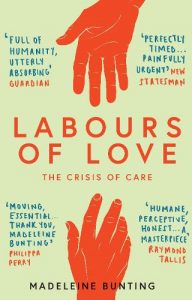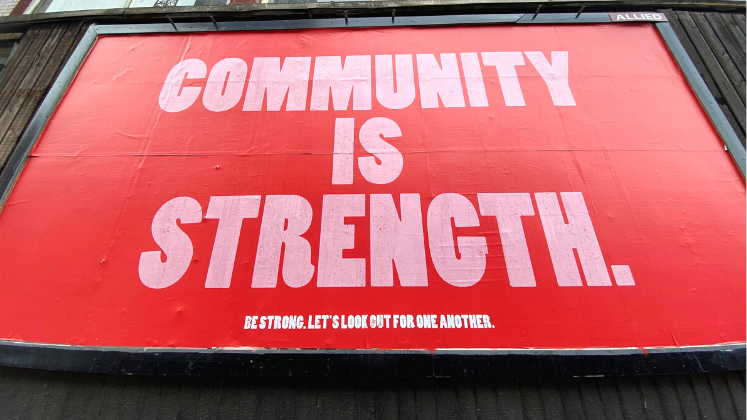In Labours of Love: The Crisis of Care, Madeleine Bunting astutely examines the often invisible world of care, showing how swathes of the care economy remain hidden and undervalued. Full of insight and humanity, this beautifully written book asks important questions about the deficit of care in our society, to which there are no easy answers, writes John Tomaney.
Labours of Love: The Crisis of Care. Madeleine Bunting. Granta. 2020.
Find this book (affiliate link):![]()
 The idea that the UK is in the midst of a ‘care crisis’ is both a commonplace of British politics and seemingly impervious to solution. The crisis tends to be reduced to a concern with the costs of providing adult social care and how these might be met in an ageing society. We speak blithely about a ‘care industry’, which suggests a concern with returns on investment and profits to earnings ratios, rather than the means to a shared humanity. So, what do we mean by care? What does it mean to care for others? Who bears the burdens of care? And how has the way we care changed over time?
The idea that the UK is in the midst of a ‘care crisis’ is both a commonplace of British politics and seemingly impervious to solution. The crisis tends to be reduced to a concern with the costs of providing adult social care and how these might be met in an ageing society. We speak blithely about a ‘care industry’, which suggests a concern with returns on investment and profits to earnings ratios, rather than the means to a shared humanity. So, what do we mean by care? What does it mean to care for others? Who bears the burdens of care? And how has the way we care changed over time?
In Labours of Love: The Crisis of Care, Madeleine Bunting is revealed as an astute observer of the often invisible world of care and its attendant imprecisions, deficits and exploitations. The book draws on Bunting’s personal experience of care – mainly as a giver, it seems – but also rests on accounts of care given and received in a variety of settings by professionals and others. Midwives, district nurses, ward sisters, GPs and chaplains, together with those caring for relatives, are all given a voice. Stories of discrete sacrifices and kindnesses appear throughout the book. The main chapters of the book are separated by rich etymological investigations into words we use freely but which are morally and sociologically conflicted: care, empathy, kindness, compassion, pity, dependence, suffering.
Bunting argues that ‘care is the feminist issue’ (3) because its burdens fall unevenly on (some) women. She identifies the particular fate of the middle-aged woman still caring for her children and, at the same time, for elderly relatives. Care, traditionally, was the work of women because ‘caring is engrained in the definition of what it is to be a woman, a wife, a mother, sister and daughter’ (16).
Women’s work in the care economy is governed, according to Bunting, not by Adam Smith’s ‘invisible hand’ but by the ‘invisible heart’. Historically, at least, the vast care economy was confined to the home and overlooked and unmeasured by economics, despite its centrality to the reproduction of capitalist enterprise. Today, the ‘care sector’ is a fast-growing part of the economy and increasingly in the hands of the private sector: ‘Care has become a thing, subject to consumers’ desires, and available as part of a monetary transaction’ (25). Care is for sale. It is a business opportunity. Consumerism rules. A nurse tells Bunting this breeds a ‘culture of entitlement’.

Image Credit: Photo by Shoeib Abolhassani on Unsplash
Despite the advance of marketisation, Bunting notes, swathes of the care economy remain hidden and its currency of time, attention, empathy, respect, tact, trust, dignity, discretion, reciprocity and solidarity is undervalued. She shows that care relies simultaneously on expertise and matriculated skills, and on tacit knowledge, the power of touch and wordless reassurance. These different aspects of care are not always successfully conjoined. The provision of care can be routine and repetitive, but at the same time attentive and compassionate. Care takes place in the interstices of the quantifiable and the ineffable.
Bunting notes that many professionals she interviewed came from strongly religious backgrounds, even if they themselves were non-believers. A kind of lingering religious sensibility continues to organise aspects of care, she suggests, and she wonders whether secular humanism will be robust enough to sustain an ethic of care in the face of its continuing commodification.
Rising rates of female labour market participation increase the need for non-household forms of care, but in an era of austerity this is a recipe for crisis. The state responds by tightening the criteria for the provision of care, and providers by holding down costs and cutting wages. The care sector is marked by endemic low pay and declining workforce retention rates. Immigration has filled labour gaps, but in the aftermath of Brexit (and the COVID-19 pandemic) many sources of migrant workers have dried up.
The book traces the story of care from birth through to death. Bunting is critically concerned with ideas of motherhood and how they shape women’s commitment to care. Her own attitudes to motherhood, she suggests, drew on ‘a template buried in memories of being mothered myself’ (46). For Bunting, motherhood was the beginning of a journey away from the orthodoxies of feminism. Parenting threw up moral dilemmas that feminism failed to solve. Feminism won a new role for women in the world of work, but the workplace is organised around the imperatives of productivity and efficiency, while parenting requires patience and the acceptance of distractions and interruptions.
Personal and societal problems are ‘solved’ by the purchase of care in the market, but this kind of care is itself governed by the rules of efficiency. We speak of ‘care packages’ for ‘service users’ in ways that are dehumanising. Bunting offers powerful testimony from workers in the private care sector frustrated by their inability to give the attention they believe their clients need because their time is parcelled into small packets. Within hospitals and local doctors’ surgeries, similar pressures apply. Even the care of the dying ‘has not just become medicalized but bureaucratized’ (229).
Bunting pays particular attention to the profession of nursing where many of her concerns are brought into stark relief. Modern nursing was invented by Florence Nightingale, a brilliant polymath and an expert in statistics, management, hygiene and communication. But she emphasised a model of nursing based on self-effacement and traditional gender stereotypes in order to create space for a new profession for women. Ever since, Bunting observes, ‘Nursing has been idealized, sentimentalized and vilified’ (102). It is both underrated and highly demanding. Nurses must employ reason and emotion, competence and compassion, and act with efficiency and humanity. Nurses are aware that they are involved in a performance but know the giving of care must never appear routine. The business of nursing is increasingly credentialed and technical with less time for the human aspects of care, which are devolved to auxiliary workers.
Between the marketplace and rigid bureaucracy, where is the space for new models of care? Bunting notes that William Beveridge, original architect of the British welfare state, envisioned a role for ‘friendly societies’ – non-governmental providers – for the provision of healthcare. But this was a road not taken. Instead, a highly centralised national health service prevailed, which adopted a medicalised approach to care, valuing technical expertise over human values. Where this approach has resulted in poor care, such as in the notorious case of Mid Staffordshire NHS Trust, health managers respond with programmes and associated performance indicators to promote compassion, as if this can be legislated and quantified.
Contained within the book is a critique of feminism. Bunting argues that ‘Women’s Liberation’ defined itself against care. Simone de Beauvoir’s The Second Sex (1949) appeared just as the servant class disappeared. As middle-class women were called upon to fill the gap, they demanded work outside the home. Women moved into the workforce, but men failed to assume an equal share of domestic tasks. Some feminists abandoned motherhood; socialists called for ‘wages for housework’. But women continue to care, and this is feminism’s blind spot, according to Bunting.
This is a beautifully written book, full of insight and humanity. It asks important questions about the deficit of care in our society, to which there are no easy answers.
Note: This review gives the views of the author, and not the position of the LSE Review of Books blog, or of the London School of Economics and Political Science. The LSE RB blog may receive a small commission if you choose to make a purchase through the above Amazon affiliate link. This is entirely independent of the coverage of the book on LSE Review of Books.







